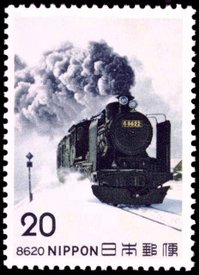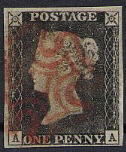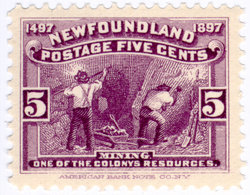Postage stamp

A postage stamp is evidence of pre-paying a fee for postal services. Usually a small paper rectangle which is attached to an envelope, signifying that the person sending the letter or package has paid for delivery, it is the most popular alternative to using a prepaid-postage envelope.
Stamps have been issued in other shapes, however: the circular stamps of New Zealand, triangular and pentagonal, and Sierra Leone and Tonga have issued self-adhesive stamp in the shape of fruit, Bhutan has issued a stamp with its national anthem on a playable record, etc. Stamps have also been made of materials other than paper, commonly embossed foil; Switzerland made a stamp partly out of lace and one out of wood, the United States produced one made of plastic, and the German Democratic Republic once issued a stamp made entirely of synthetic chemicals.
History

The adhesive postage stamp and the uniform postage rate were devised in Great Britain by James Chalmers around 1834. The same ideas were brought forward by Lovrenc Kosir, a Slovenian postal clerk at the Viennese court in 1835, but did not meet a favorable response. Later, the concept of the adhesive postage stamp was published by Rowland Hill, in Postal Reform: its Importance and Practibility in 1837. In it he argued that it would be better for the sender to pay the cost of delivery, rather than the addressee who could refuse the letter if they could not or did not want to pay, as sometimes happened at the time. He also argued for a uniform rate of one penny per letter, no matter where its destination. Accounting costs for the government would thus be cut; postage would no longer be charged according to how far a letter had travelled, which required each letter to have an individual entry in the Royal Mail's accounts. Chalmers' ideas were finally adopted by Parliament in August, 1839 and the General Post Office launched the Penny Post service the next year in 1840 with two prepaid-postage pictorial envelopes or wrappers: one valued at a penny and one valued at twopence.
Three months later the first prepaid-postage stamp, known as the Penny Black was issued with the profile of Queen Victoria printed on it. Because the United Kingdom issued the first stamps, the Universal Postal Union (U.P.U.) grants it an exemption from its rule that the identification of the issuing country must appear on a stamp in Roman script for use in international mails. Before joining the U.P.U. many countries did not do this (e. g. the "bullseye" stamps of Brazil); there are very few violations of the rule since this time, though one example is the U.S. Pilgrim Tercentenary series, on which the country designation was inadvertently excluded. Because of this the numerous early issues of China and Japan often confound new collectors unfamiliar with Oriental scripts. A stamp may also show a face value in the issuing country's currency. Some countries have issued stamps with a letter of the alphabet or designation such as "First class" for a face value. The U.P.U. formerly restricted the use of such stamps to domestic mail, but current U.P.U. regulations allow non-denominated stamps to be used in international mail as well. [1] Examples of such stamps include the British "E" stamp (intended to pay the rate for mailing letters to Europe) and the South African "International Letter Rate" stamp.
Dispensing
Since their inception there have been numerous innovative developments in how stamps have been dispensed and sold. Recently one has been able to print up postage stamps from one's personal computer. In 2002 the United States Postal Service licensed Stamps.com to issue NetStamps, digital stamps that can be printed up on special labels and, unlike previous postage the USPS licensed individuals to print up on their computers, that can be used on any date, not just the date one prints them up. (There are other types of computer-vended postage as well.)
For instance, ATM stamps are sold at automatic teller machines (ATMs), although they may be sold via stamp catalogues of the postal service or possibly at philatelic windows. They must be the same size and thickness as currency in order to be dispensed by the ATM.

Types of stamps
- Airmail - for payment of airmail service. While the word or words "airmail" or equivalent is usually printed on the stamp, Scott (the dominant U.S. cataloguing firm) has recognised as airmail stamps some U.S. stamps issued in denominations good for then-current international airmail rates, and showing the silhouette of an airplane. The other three major catalogs do not give any special status to airmail stamps.
- ATM
-
- stamps dispensed by automatic teller machines (ATMs)
- Automatenmarken, stamps issued in the denomination of the customer's choice by a kind of machine (similar to computer-vended postage) are also referred to by the acronym ATM, which has created some confusion.
- carrier's stamp
- certified mail stamp
- commemorative stamp - a limited run of stamp designed to commemorate a particular event
- definitive - stamps issued mainly for the everyday payment of postage. They often have less appealing designs than commemoratives. The same design may be used for many years. Definitive stamps are often the same basic size. The use of the same design over an extended period of time often leads to many unintended varieties. This makes them far more interesting to philatelists than commemoratives.
- express mail stamp / special delivery stamp
- late fee stamp - issued to show payment of a fee to allow inclusion of a letter or package in the outgoing dispatch although it has been turned in after the cut-off time
- local post
- military stamp - stamps issued specifically for the use of members of a country's armed forces, usually using a special postal system
- official mail stamp - issued for use solely by the government or a government agency or bureau
- occupation stamp - a stamp issued for use by either an occupying army or by the occupying army or authorities for use by the civilian population
- parcel post
- perforated stamps - while this term is often used to refer to the perforations around the edge of a stamp (used to divide the sheet into individual stamps) it is also a technical term for stamps which have been additionally perforated across the middle leaving a distinctive pattern or monogram. These modified stamps are usually purchased by large corporations to guard against theft by their employees.
- personalized - allow user to add his own personalized picture or photograph
- postage due - a stamp applied showing that the full amount of required postage has not been paid, and indicating the amount of shortage and penalties the recipient will have to pay. (Collectors and philatelists debate whether these should be called stamps, some saying that as they do not pre-pay postage they should be called "labels".) The United States Post Office Department issued "parcel post postage due" stamps.
- postal tax - a stamp indicating that a tax (above the regular postage rate) required for sending letters has been paid. This stamp is often mandatory on all mail issued on a particular day or for a few days only.
- registered - for pre-payment of a registery fee (fee for "registered mail").
- sanitary fair
- self-adhesive stamp - stamps not requiring licking or moisture to be applied to the back to stick. Self-sticking.
- semi-postal / charity stamp - a stamp issued with an additional charge above the amount needed to pay postage, where the extra charge is used for charitable purposes such as the Red Cross. The usage of semi-postal stamps is entirely at the option of the purchaser. Countries (such as Belgium and Switzerland) that make extensive use of this form of charitable fund-raising design such stamps in a way that makes them more desirable for collectors.
- special handling - gave parcel post mail first-class treatment in the United States.
- test stamp - these labels are not valid for postage and are not usually available to the public. They are used by postal authorities on sample mail to test various sorting and cancelling machines or machines that can detect the absence or presence of a stamp on an envelope. Putting a stamp on the upper left corner of an envelope can confuse these machines.
- war tax stamp - A variation on the postal tax stamp intended to defray the costs of war.
- water-activated stamp - for many years "water-activated" stamps were the only kind so this term only entered into use with the advent of self-adhesive stamps. The adhesive or gum on the back of the stamp must be moistened (usually it is done by licking, thus the stamps are also known as "lick and stick") to affix it to the envelope or package.
Souvenir sheets
Postage stamps are sometimes issued in souvenir sheets containing just one or a small number of stamps. Souvenir sheets typically include additional artwork or information printed on the selvage (border surrounding the stamps).
Cinderellas
Stamps should be distinguished from cinderellas, stamp-like labels that resemble, but are not, postage stamps. Cinderellas might be commemorative labels, such as those issued to support the Transmississippi Exposition in Buffalo, New York (USA) in 1901 (one of these has now been converted into an actual postage stamp), or may be postage stamps for imaginary countries or micronations.
Test stamps
"Test stamps" are not actually postage stamps but for testing printing processes, equipment, and the like.
In the United Kingdom test stamps for coil dispensing machines are sometimes known as poached eggs, because of their design. They are printed the same size and format as the definitives and perforated in the same manner. The amount of ink used is also the same as actual postage stamps, so that they can be used to test the machines with material as close as possible to the actual postage stamps. The colour of these test stamps was changed from green to black after 1937 when some test coils were accidentally left in a machine and used as half-penny stamps. At the time of this colour change, text was also added to the centre of the labels indicating their use.
Collecting
Stamp collecting is a popular hobby.
Some countries are known for producing stamps intended for collectors rather than postal use. This practice produces a significant portion of the countries' government revenues. This has been condoned by the collecting community for places such as Liechtenstein and Pitcairn Islands that have followed relatively conservative stamp issuing policies. Abuses of this policy, however, are generally condemned. Among the most notable abusers have been Nicholas F. Seebeck and the component states of the United Arab Emirates. Seebeck operated in the 1890s as an agent of Hamilton Bank Note Company when he approached several Latin American countries with an offer to produce their entire postage stamp needs for free. In return he would have the exclusive rights to market the remainders of the stamps to collectors. Each year a new issue of stamps was produced whose postal validity would expire at the end of the year; this assured Seebeck of a continuing supply of remainders. In the 1960s certain stamp printers such as the Barody Stamp Company arranged contracts to produce quantities of stamps for the separate Emirates and other countries. These abuses combined with the sparse population of the desert states earned them the reputation of being known as the "sand dune" countries.
The combination of hundreds of countries, each producing scores of different stamps each year has resulted in a total of some 400,000 different types in existence as of 2000. In recent years, the annual world output has averaged about 10,000 types each year.
Famous stamps
See also: List of postage stamps
- Penny Black
- Mauritius Blue Penny
- Treskilling Yellow
- Inverted Jenny
- British Guiana 1c magenta
- Perot provisional
- Hawaii Missionaries
- Basel Dove
- Uganda Cowries
- Scinde Dawk
- Gronchi Rosa very rare Italian stamp
See also
- List of postage stamps
- List of entities that have issued postage stamps
- List of ships on stamps
- List of people on stamps
- List of birds on stamps
- List of bonsai on stamps
- List of fish on stamps
- List of errors on Portuguese ex-Colonies stamps
- Artistamp
- Philatelic investment
- Stanley Gibbons
- Timeline of postal history
External links
- Stanley Gibbons Ltd
- Joseph Luft's Philatelic Resources on the Web - largest collection of links to other stamp-related sites
- philately.com
- Austrian personalized stamp service
- PhotoStamps - U.S. customized stamp service
